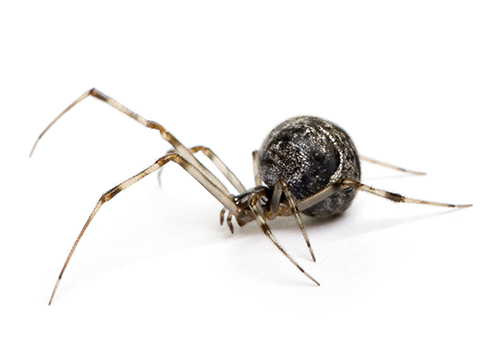Spiders spin possible solution to 'sticky' problems

This spider is an Achaearanea tepidariorum.
The Akron scientists created synthetic duplicates of the super-sticky, silk “attachment discs” that spiders use to attach their webs to surfaces. These discs are created when spiders pin down an underlying thread of silk with additional threads, like stiches or staples, explains Ali Dhinojwala, UA’s H.A. Morton professor of polymer science and lead researcher on the project.
This “staple-pin” geometry of the attachment disc creates a strong attachment force using little material, he adds.
Through electrospinning, a process by which an electrical charge is used to draw very fine fibers from a liquid (in this case, polyurethane), Dhinojwala and his team were able to mimic the efficient staple-pin design, pinning down an underlying nylon thread with the electrospun fibers.
“This adhesive architecture holds promise for potential applications in the area of adhesion science, particularly in the field of biomedicine where the cost of the materials is a significant constraint,” the authors write in their paper, “Synthetic Adhesive Attachment Discs Inspired by Spider’s Pyriform Silk Architecture,” published online March 1 in the Journal of Polymer Physics.
Dhinojwala adds that the design could potentially be used, in addition to medical applications, to create commercial adhesives stronger than conventional glue and tape.
“Instead of using big globs of glue, for example, we can use this unique and efficient design of threads pinning down a fiber,” he says. “The inspiration was right in front of us, in nature.”
“You can learn a lot of science from nature,” adds Dharamdeep Jain, a graduate student and co-author of the paper.
Indeed, researchers at UA have been learning quite a bit from nature’s silk-spinning artists.
Dhinojwala and Vasav Sahni, former graduate student and third co-author of the aforementioned paper, previously worked together to study the adhesive properties of spider silk; and last year Todd Blackledge, Leuchtag Endowed Chair and associate professor of biology and integrated bioscience at UA, revealed the possibilities of using silk to develop materials that are as strong as steel and yet flexible as rubber.
Story by Nicholas Nussen
Media contact: Denise Henry, 330-972-6477 or henryd@uakron.edu.
Media Contact
All latest news from the category: Materials Sciences
Materials management deals with the research, development, manufacturing and processing of raw and industrial materials. Key aspects here are biological and medical issues, which play an increasingly important role in this field.
innovations-report offers in-depth articles related to the development and application of materials and the structure and properties of new materials.
Newest articles

Machine learning algorithm reveals long-theorized glass phase in crystal
Scientists have found evidence of an elusive, glassy phase of matter that emerges when a crystal’s perfect internal pattern is disrupted. X-ray technology and machine learning converge to shed light…

Mapping plant functional diversity from space
HKU ecologists revolutionize ecosystem monitoring with novel field-satellite integration. An international team of researchers, led by Professor Jin WU from the School of Biological Sciences at The University of Hong…

Inverters with constant full load capability
…enable an increase in the performance of electric drives. Overheating components significantly limit the performance of drivetrains in electric vehicles. Inverters in particular are subject to a high thermal load,…





















